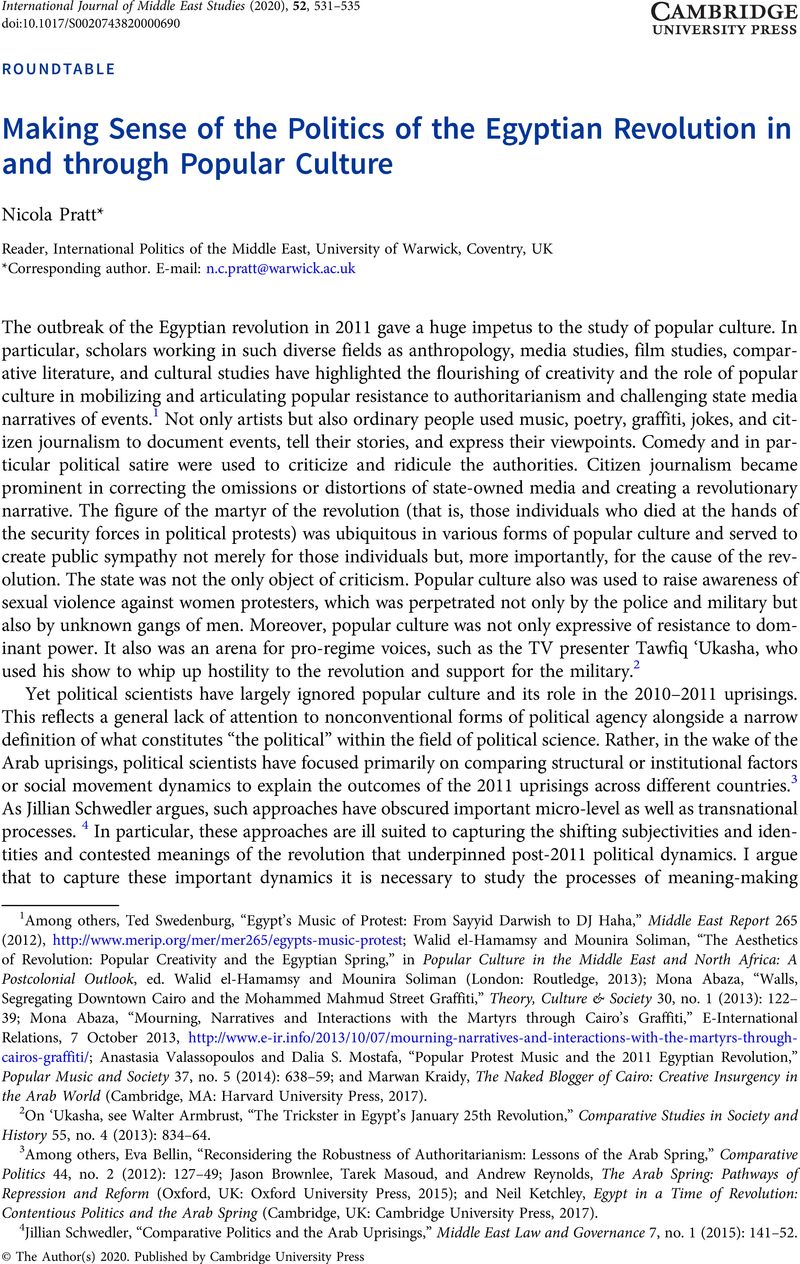No CrossRef data available.
Article contents
Making Sense of the Politics of the Egyptian Revolution in and through Popular Culture
Published online by Cambridge University Press: 07 September 2020
Abstract

- Type
- Roundtable
- Information
- Copyright
- Copyright © The Author(s) 2020. Published by Cambridge University Press
References
1 Among others, Ted Swedenburg, “Egypt's Music of Protest: From Sayyid Darwish to DJ Haha,” Middle East Report 265 (2012), http://www.merip.org/mer/mer265/egypts-music-protest; el-Hamamsy, Walid and Soliman, Mounira, “The Aesthetics of Revolution: Popular Creativity and the Egyptian Spring,” in Popular Culture in the Middle East and North Africa: A Postcolonial Outlook, ed. el-Hamamsy, Walid and Soliman, Mounira (London: Routledge, 2013)CrossRefGoogle Scholar; Abaza, Mona, “Walls, Segregating Downtown Cairo and the Mohammed Mahmud Street Graffiti,” Theory, Culture & Society 30, no. 1 (2013): 122–39CrossRefGoogle Scholar; Mona Abaza, “Mourning, Narratives and Interactions with the Martyrs through Cairo's Graffiti,” E-International Relations, 7 October 2013, http://www.e-ir.info/2013/10/07/mourning-narratives-and-interactions-with-the-martyrs-through-cairos-graffiti/; Valassopoulos, Anastasia and Mostafa, Dalia S., “Popular Protest Music and the 2011 Egyptian Revolution,” Popular Music and Society 37, no. 5 (2014): 638–59CrossRefGoogle Scholar; and Kraidy, Marwan, The Naked Blogger of Cairo: Creative Insurgency in the Arab World (Cambridge, MA: Harvard University Press, 2017)Google Scholar.
2 On ‘Ukasha, see Armbrust, Walter, “The Trickster in Egypt's January 25th Revolution,” Comparative Studies in Society and History 55, no. 4 (2013): 834–64CrossRefGoogle Scholar.
3 Among others, Bellin, Eva, “Reconsidering the Robustness of Authoritarianism: Lessons of the Arab Spring,” Comparative Politics 44, no. 2 (2012): 127–49CrossRefGoogle Scholar; Brownlee, Jason, Masoud, Tarek, and Reynolds, Andrew, The Arab Spring: Pathways of Repression and Reform (Oxford, UK: Oxford University Press, 2015)CrossRefGoogle Scholar; and Ketchley, Neil, Egypt in a Time of Revolution: Contentious Politics and the Arab Spring (Cambridge, UK: Cambridge University Press, 2017)CrossRefGoogle Scholar.
4 Schwedler, Jillian, “Comparative Politics and the Arab Uprisings,” Middle East Law and Governance 7, no. 1 (2015): 141–52CrossRefGoogle Scholar.
5 Wedeen, Lisa, “Conceptualizing Culture: Possibilities for Political Science,” American Political Science Review 96, no. 4 (2002): 713–28CrossRefGoogle Scholar.
6 Ibid.
7 Antonio Gramsci, Selections from the Prison Notebooks, ed. Geoffrey Nowell-Smith, trans. Quinton Hoare (London: Lawrence and Wishart, 1971), 161. I have previously studied the construction of regime hegemony through the reproduction of particular notions of Egyptian identity and nationalism. For example, see Nicola Pratt, “Identity, Culture, and Democratization: The Case of Egypt,” New Political Science 27, no. 1 (2005): 69–86.
8 This project, entitled “Politics and Popular Culture: Contested Narratives of the 25 January 2011 Revolution and its Aftermath,” was funded by the UK Arts and Humanities Research Council (no. AH/N004353/1) and was conducted by Nicola Pratt, Dalia Mostafa, Dina Rezk, and Sara Salem. The project website can be found at https://warwick.ac.uk/fac/soc/pais/research/researchcentres/cpd/popularcultureegypt/. An online archive based on the project called “Politics, Popular Culture and the 2011 Egyptian Revolution” can be found at https://egyptrevolution2011.ac.uk/.
9 For a useful discussion of different definitions of popular culture, see John Storey, Cultural Theory and Popular Culture: An Introduction (Abingdon, UK: Routledge, 2010), 5–11.
10 Walid el-Hamamsy and Mounira Soliman, “Introduction: Popular Culture—A Site of Resistance,” in Popular Culture in the Middle East and North Africa, 1–2.
11 James R. Grippo, “The Fool Sings a Hero's Song: Shaaban Abdel Rahim, Egyptian Shaabi, and the Video Clip Phenomenon,” Transnational Broadcasting Studies 16 (2006), https://www.arabmediasociety.com/the-fool-sings-a-heros-song-shaaban-abdel-rahim-egyptian-shaabi-and-the-video-clip-phenomenon/.
12 Farah Montasser, “A Year of El-Fan Midan in Egypt,” Ahram Online, 10 April 2012, http://english.ahram.org.eg/NewsContent/5/0/38785/Arts--Culture/0/A-year-of-ElFan-Midan-in-Egypt.aspx.
13 Stuart Hall, “Notes on Deconstructing the ‘Popular,’” in People's History and Socialist Theory, ed. Raphael Samuel (Abingdon, UK: Routledge, 1981), 234.
14 El-Hamamsy and Soliman, “Introduction,” 1–2.
15 Such attitudes toward culture are elaborated in Winegar, Jessica, Creative Reckonings: The Politics of Art and Culture in Contemporary Egypt (Stanford, CA: Stanford University Press, 2006)Google Scholar. For a discussion of the relationship between intellectuals and the people in the context of the 2011 Egyptian revolution, see el-Desouki, Ayman, The Intellectual and the People in Egyptian Literature and Culture (London: Palgrave MacMillan, 2014)CrossRefGoogle Scholar. For a discussion of the politics motivating the organizers of El-Fann Midan, see Sprengel, Darci, “Loud and Quiet Politics: Questioning the Role of the Artist in Street Art Projects after the 2011 Revolution,” International Journal of Cultural Studies 23, no. 2 (2020): 208–26CrossRefGoogle Scholar.
16 Winegar, Jessica, “A Civilised Revolution: Aesthetics and Political Action in Egypt,” American Ethnologist 43, no. 4 (2016): 609–22CrossRefGoogle Scholar.
17 Marie-Jeanne Berger, “Cultural Enlightenment for Cairo's Downtown Futures,” Mada, 17 July 2014, https://madamasr.com/en/2014/07/17/feature/culture/cultural-enlightenment-for-cairos-downtown-futures/.
18 Swedenburg, “Egypt's Music.”
19 Tarek Adam Benchouia, “Festivals: The Culture and Politics of Mahraganat Music in Egypt” (MA thesis, University of Texas at Austin, 2015).
20 See the 2013 feature documentary Ele Beheb Rabena Erfaa Edoh Lefook, dir. Salma el-Tarzi, which explores the mahraganat music scene in Cairo.
21 Elliott Colla, “The People Want,” Middle East Report, 263 (2012), http://www.merip.org/mer/mer263/people-want.
22 el-Falaky, Mai Samir, “The Representation of Women in Street Songs: A Critical Discourse Analysis of Egyptian Mahraganat,” Advances in Language and Literary Studies 6, no. 5 (2015)Google Scholar.
23 Bennett, Tony, “Popular Culture and the Turn to Gramsci,” in Popular Culture and Social Relations, ed. Bennett, Tony, Mercer, Colin, and Woollacott, Janet (Milton Keynes, UK: Open University Press, 1986), xvGoogle Scholar.
24 Benchouia, “Festivals.”
25 Ismail, Salwa, Political Life in Cairo's New Quarters: Encountering the Everyday State (Minneapolis: University of Minnesota Press, 2006)Google Scholar.
26 ‘Ali al-Haggar, “Ihna Sha‘b wa Intu Sha‘b,” July 2013, https://www.youtube.com/watch?v=lE58cI5cAxA&feature=youtu.be.
27 Pratt, Nicola and Rezk, Dina, “Securitizing the Muslim Brotherhood: State Violence and Authoritarianism in Egypt after the Arab Spring,” Security Dialogue 50, no. 3 (2019): 239–56CrossRefGoogle Scholar.
28 Mohamed Andeel, Souvenir Portrait of the Great Egyptian Family (in Arabic), al-Masry al-Youm Online, July 2013. Reprinted at https://africacartoons.com/mohamed-andeel-a-picture-of-egyptian-people/.





